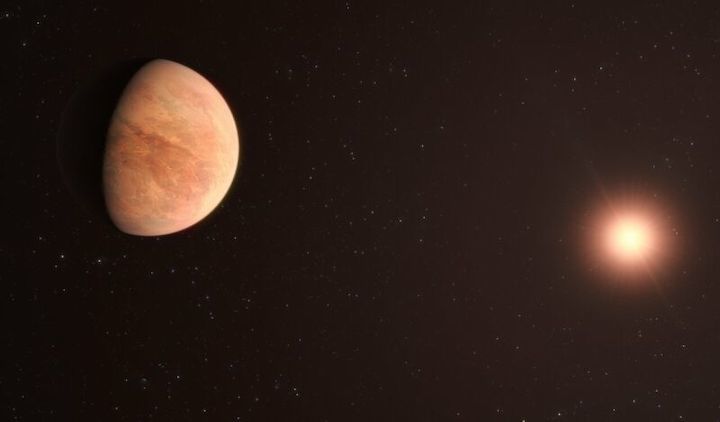10.08.2021
A 3-planet system may expand out to 5, and one of its members is pretty small.

This artist’s impression shows L 98-59b, one of the planets in the L 98-59 system 35 light-years away
Most of the exoplanets we've discovered have been identified by large surveys like the Kepler mission or the Transiting Exoplanet Survey Satellite (TESS). While these projects are great at spotting stars that host planets, they mostly just tell us that the planets are there. Understanding an exosolar system and its planets requires multiple follow-up observations—and the telescope time that goes with them. Here, the phenomenal success of the surveys has given us far more to observe than we can get to conveniently.
But the follow-ups can provide critical information, as a study released this week makes clear. In it, the researchers describe observations of a three-planet system discovered by TESS. Using the additional observations, the researchers find that there are likely to be two other planets that TESS couldn't see and that one it spotted is the least massive exoplanet described to date.
The follow-through
The system is called L 98-59, and it has a couple of properties that make it a great candidate for follow-on observations. One advantage is that it's fairly close, at least in galactic terms, being only about 35 light-years from Earth. It's also located where it will spend a lot of time within the field of view of the James Webb Space Telescope, should that mission successfully reach its operational orbit. That means researchers won't have too much trouble obtaining enough imaging to study the atmospheres of the system's planets.
TESS spots planets by watching for the drop in light that occurs as planets pass between their host star and Earth. So others followed this study with observations that used radial velocity measurements, which watch for shifts in the star's light that occur as its planets' gravity pull it in different directions. Radial velocity can give us a planet's likely mass; combined with the planet's size provided by TESS, this can tell us a planet's density and thus offers hints about its composition.
Unfortunately, there wasn't enough telescope time to narrow the uncertainties down much. The new paper presents many additional observations that were done using an instrument hooked up to the European Southern Observatory's Very Large Telescope in Chile.
The standard means of analyzing this sort of data is to identify the strongest periodic signal caused by a planet and remove it from the data, then keep doing it until you run out of statistically significant signals. Intriguingly, when this analysis got to the point where the three planets identified by TESS were removed, there were still signals left. The signals indicated the clear presence of a fourth planet—and the possible presence of a fifth (models with four and five planets were equally consistent with the data).
What’s in L 98-59?
One obvious thing to examine is to see if the other planets were apparent, but their signals hadn't been recognized. To check this out, the researchers relied on software called (and I'm not making this up) the Bad-Ass Transit Model cAlculatioN, or BATMAN. But in the transit data, the planets just aren't there.
This isn't a major problem. Transits rely on a careful alignment of the exosolar system, where the planets orbit in a plane that intersects with Earth. If not every planet orbits precisely within this plane, they may not transit from Earth's perspective. Still, it means we either need additional data or a careful analysis to look for gravitational interactions among the planets, which can influence the timing of their transits.
If the fifth planet exists, it's about 2.5 times the mass of Earth, so it's likely to be rocky. It would also be in the middle of the habitable zone of L 98-59, where liquid water could potentially exist on the planet's surface. Because L 98-59 is a small, dim star, however, the habitable zone is so close that the planet would only take 23 days to complete an orbit.
Because radial velocity detection tells us the mass of a planet and watching the planet transit gives us its size, we now know the density of the three planets that were detected by both methods. Two are somewhat less dense than Earth, suggesting that they're similar in structure, with the exception of having a smaller iron core. In contrast, the third is only about half of Earth's density, suggesting it could be as much as 30 percent water—an ocean world.
The other striking discovery is the mass of one of the Earth-like planets. It's less than half that of Earth's, leaving the planet substantially more massive than Mercury and Mars but less than half the mass of Venus. It's thus the smallest confirmed exoplanet discovered to date. Based on the Solar System, we'd expect there to be a good number of planets this size or smaller. So it's encouraging that we're finally detecting them.
At this point, there are thousands of candidates for planets that we haven't examined. A lot of similar surprises could be waiting for us. In the meantime, surveys like TESS will continue to add to the list of objects we need to check out more carefully.
Quelle: arsTechnica

